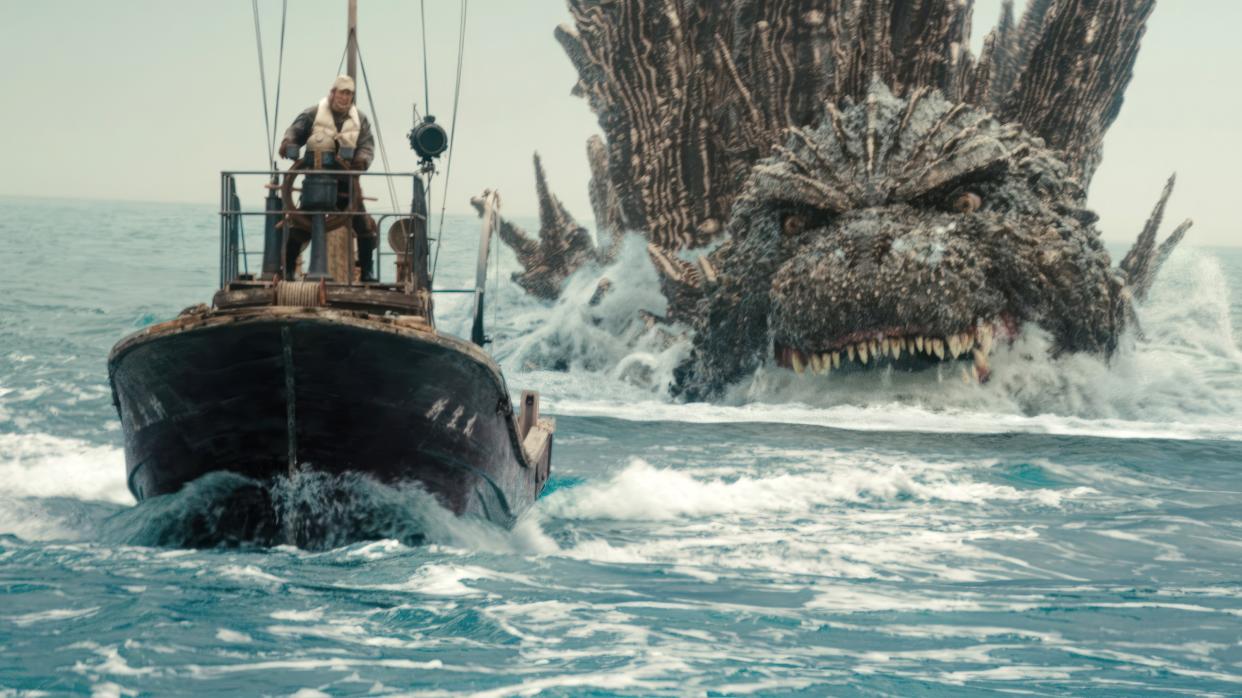Japan Wins First Best Visual Effects Oscar for ‘Godzilla Minus One’

- Oops!Something went wrong.Please try again later.
- Oops!Something went wrong.Please try again later.
“Godzilla Minus One” already made history at the Oscars on January 23 when it became the first film in the Godzilla franchise’s 70 years to be nominated for Best Visual Effects. Now, director Takashi Yamazaki can claim the title of Japan’s first ever winner of the Best Visual Effects Oscar. Even more, this is the first Godzilla film to win an Oscar, period.
Yet even more history was by the Toho Studios production on March 10 at the 96th Academy Awards: director Yamazaki is also the winner of this particular Visual Effects prize, as he also served as the film’s visual effects supervisor. A director winning the Best Visual Effects Academy Award has only happened once more before, with Stanley Kubrick taking the honor in 1969 for “2001: A Space Odyssey” as VFX supervisor on that Best Picture nominee as well. (That’s also the only Oscar Kubrick won in his nearly 50-year-long career.)
More from IndieWire
Takashi Yamazaki also wrote the screenplay for this latest Godzilla, set after World War II as the Toho monster emerges on the shores of Tokyo, based on the iconic character originated in Ishirô Honda’s flagship 1954 film.
“For nearly 40 years I have been making films while admiring the artistry of Hollywood Visual Effects, and I feel that I have finally come this far,” said Takashi Yamazaki in a statement after this year’s nominations were announced. “I had not set my sights on being nominated, but I am very happy to have been brought to this place … I think it is a wonderful day for Godzilla!” (A viral video also showed the crew reacting to the January 23 nomination elatedly.)
As IndieWire’s Jim Hemphill wrote when assessing what films would and should win in this year’s crafts Oscars race, “Yamazaki’s extraordinary work on ‘Godzilla Minus One’ makes it seem likely that he could follow in Kubrick’s footsteps. The film is filled with awe-inspiring images, particularly when it comes to Yamazaki’s conception and execution of his famous title character; the rich texture, detail, and weight he brings to the creature make Godzilla the most convincing and terrifying monster of its type since the dinosaurs in ‘Jurassic Park.’ Even more impressive is that this exceptional monster and its surrounding destruction were all achieved on a production budget (reportedly $15 million) far, far lower than any of the other films in this category.”
“Godzilla Minus One” was impressively up against other nominees including “The Creator,” “Mission: Impossible — Dead Reckoning,” “Napoleon,” and “Guardians of the Galaxy Vol. 3.”
Yamazaki notably did not employ any A.I. generative technology to develop the visual effects for “Godzilla Minus One,” working with production house Shirogumi on a team alongside 35 artists — a relative skeleton crew compared to the other films nominated here, but not unusual for Japanese productions that historically work on a smaller scale. A film like “Guardians of the Galaxy Vol. 3” employed a reported 400 artists — again, not unusual for a Marvel title whose artisans are strapped and ever under the gun to get deliverables out the door. Yamazaki, meanwhile, was hands-on with his team every day on site.
“In terms of what I wanted to do with ‘Godzilla,’” Yamazaki told IndieWire, “I’m a huge fan of the very first 1954 ‘Godzilla.’ And to me, that film was a response to nuclear warheads and where the world was heading at that point in time. So Godzilla being this metaphor for nuclear warheads, I think, was very important to return to and not forget. During the production, it was both surprising and disturbing to see the state of the world unfold and reading the headlines because we were making a film about Godzilla and the subject matter it represents. And in some weird way, I feel, the timing of different Godzilla films, especially with the the context of Japan, it almost feels like this divine ritual or offering to the gods of some sort.”
Toho opened “Godzilla Minus One” in U.S. theaters on December 1 and eventually to an impressive total of $56 million domestic. Strangely, though, the film is currently not available on home viewing platforms stateside, and its theatrical run has since ended. A grittier black-and-white version was later released in Japan and the United States in late January 2024.
From IndieWire’s “Godzilla Minus One” review: “In judging the nobility of self-sacrifice against the ambiguous morality of kamikaze warfare — posed as an injustice not to its targets, but rather to the Japanese soldiers spent like bullet casings by an indifferent state — writer/director Takashi Yamazaki does more than find a renewed purpose for an IP asset impervious to irrelevance. He’s reconciled the series’ pop thrills with the heaviness of its political subtext more skillfully than anyone since the rubber-suit days by melding the two into an ideological spectacle to rival Sergei Eisenstein’s, both in its foregrounded populist leanings as well its rousing, cathartic montage in action.”
Best of IndieWire
2023 Emmy Predictions: Who Will Win at the Primetime Emmy Awards?
2023 Emmy Predictions: Outstanding Documentary or Nonfiction Special
2023 Emmy Predictions: Outstanding Documentary or Nonfiction Series
Sign up for Indiewire's Newsletter. For the latest news, follow us on Facebook, Twitter, and Instagram.

